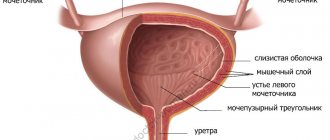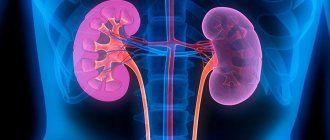Tumors of the ureter and pelvis are uncommon. They usually occur in men between 50 and 70 years of age. The exact reasons for the appearance of such neoplasms are unknown. At the moment, experts have only been able to identify factors that increase the risk of their development.
The main ones include:
- taking painkillers containing phenacetin;
- smoking;
- contact with aniline;
- endemic nephropathy;
- undergone surgery to remove the bladder.
Also at risk are people who suffer from arterial hypertension and use diuretics. The disease can also occur in those who work in oil refineries and plastics production.
Symptoms
The main sign of a tumor of the pelvis and ureter is the appearance of blood in the urine. This symptom is detected in most patients. However, a small number of patients complain of pain. Discomfort usually occurs only when a blood clot obstructs the ureter.
Important! In some cases, hematuria may stop on its own. But recovery cannot be judged by this criterion. The patient should not put off visiting the doctor until later. Blood in the urine may be detected again after a long time.
Also, the presence of a tumor of the ureter and pelvis may be indicated by such signs as:
- weight loss against the background of a general decrease in appetite;
- increased temperature over a long period of time;
- slight aching pain in the lower back.
Important! General signs of intoxication, which include loss of appetite and sudden weight loss, usually appear at a late stage. In this case, the patient is already diagnosed with renal failure and hydronephrosis.
Don't put off visiting a doctor until later! Only with timely consultation and diagnosis can you count on a quick operation and preservation of the kidney!
Conservative direction
Effective at the first stage, when the patient does not yet have kidney dysfunction. Therapy is focused on minimizing symptoms and reducing the intensity of the process. The patient is prescribed anti-inflammatory drugs, antibiotics, and medications that lower blood pressure. To eliminate pain, non-steroidal anti-inflammatory drugs and antispasmodics are prescribed. It is important to understand that such therapy is temporary or preparatory before surgery for kidney hydronephrosis.
Treatment
Tumors are treated primarily surgically. When selecting treatment tactics, the doctor evaluates a number of factors, including not only the stage of the disease, but the location of the tumor and its size. The condition of the kidneys is also taken into account, as well as the speed of spread of the pathological process.
If the kidney (located on the other side) works without abnormalities, nephroureterectomy is recommended. This intervention involves removal of the affected kidney and ureter, as well as a section of the bladder wall. This operation is performed using the laparoscopic method. This reduces the risk of injury to healthy tissue and increases the accuracy of manipulations. In addition, the laparoscopic technique reduces the patient’s time in hospital and the period of his rehabilitation after discharge.
Important! Organ-conserving surgery is especially important for patients with one kidney or chronic renal failure.
If you are planning to undergo treatment for a tumor of the pelvis and ureter at the Surgical Urology Clinic named after. I.M. Sechenova, contact us in any way convenient for you. A specialist will answer any questions you may have and schedule an appointment with a doctor at a convenient time.
Treatment tactics for hydronephrosis
Without medical support, the disease progresses rapidly. There are three degrees of pathology.
- First. Slight stretching of the renal pelvis while maintaining kidney function.
- Second. Moderate stretching and thinning of the organ wall, a decrease in renal function by more than half is observed.
- Third. Due to the expansion of the pelvis, kidney function is reduced until it stops.
There are congenital and acquired hydronephrosis. Treatment tactics are selected depending on the causes of the pathology. The first group includes:
- compression of the ureter;
- decreased normal motility of the ureter;
- abnormal localization of the ureter or renal artery;
- physiological narrowing of the ureter.
Hydronephrosis can develop due to the following pathologies:
- urolithiasis (the stone prevents the normal evacuation of fluid);
- benign and malignant neoplasms of the urinary tract;
- prostate adenoma or cancer;
- metastasis of tumors to the kidney area;
- spinal cord injuries;
- infectious diseases of the genitourinary system.
Treatment of pathology can be conservative or surgical. Therapy is carried out by urologists, nephrologists and surgeons. The choice of treatment tactics depends on the stage of the pathology, its etiology, the patient’s age and concomitant disorders.
Free consultation with a urologist
Structure of the renal pelvis
The renal pelvis is a funnel-shaped cavity that is formed by the fusion of the large and small calyces of the kidney. All urine produced in the kidney is collected in the pelvis before it travels through the ureter into the bladder. The pelvis and calyces of the kidney are a single structure, being part of the collector system. Each calyx is connected to the pelvis through a more narrowed part - the neck. When the urinary tract becomes blocked and the pelvis dilates, the calyces and cervix may also dilate, which is called calicoectasia.
The renal pelvis is lined on the inside with a thin mucous membrane. In the wall of the pelvis there is a layer of longitudinal and transverse smooth muscle fibers, the function of which is to create peristaltic contractions that extend to the ureter, moving urine down the urinary tract. The mucous membranes of the pelvis are somewhat folded so that there is some room for tissue expansion as urine distends the pelvis. The walls of the pelvis, kidney and ureter are impermeable to urine and substances dissolved in it, so the liquid never leaves the urinary system.
Abnormalities of the renal pelvis
When considering anomalies of the renal pelvis, it is always worth talking about anomalies of the pelvis and ureter, since these anatomical structures are so interconnected that the anomalies that arise at this level certainly affect both the pelvis and the ureter. However, in this section we will only partially touch on ureteral anomalies and try to cover the topic of renal pelvis anomalies.
Duplication of the pyelocalyceal system . There is a complete duplication of the collecting system , when there are two pelvises and both are connected to the bladder by separate ureters, and there is an incomplete duplication of the collecting system , when at some level the ureters are connected and flow into the bladder with one single trunk. There are many variants of this anomaly, depending on whether it is a bilateral or unilateral anomaly, on the level of connection of the ureters, etc. There are also options when three or more ureters are detected. As a rule, a person can live his whole life with this anomaly and not even know about its existence in himself. Therefore, if you were accidentally diagnosed with an abnormality in the number of the upper urinary tract and there are no clinical manifestations, then nothing needs to be done about it and there is no need to seek treatment.
Enlargement of the renal pelvis
Enlargement of the renal pelvis is an increase in the volume of the pyelocaliceal system for some reason. This pathology is also called hydronephrosis or hydronephrotic transformation of the kidney. Hydronephrosis can be congenital or acquired.
Congenital hydronephrosis of the renal pelvis
During pregnancy, fetal development abnormalities can lead to various abnormalities in the development of the kidneys and their drainage systems, including the development of renal hydronephrosis. The mechanism of development of hydronephrosis is the presence of an obstruction to the normal outflow of urine from the pelvis down the urinary tract. As a consequence, enlargement of the pelvis and calyces of the kidney and impaired renal function occur. In the future, against the background of urinary stasis, an infection may occur.
How to detect hydronephrosis of the pelvis during pregnancy?
The fetus's kidneys can be examined using ultrasound at approximately 20 weeks' gestation. Ultrasound technology allows you to evaluate the size, position and structure of the kidneys, ureters and renal pelvis.
Studies show hydronephrosis in approximately 1.4 percent of all infants who have an ultrasound scan. It is the most common abnormality found during pregnancy, accounting for about 50 percent. Hydronephrosis in children is the result of genetic abnormalities. The most common cause is narrowing of the ureteropelvic segment (the place where the pelvis meets the ureter). Another cause of hydronephrosis is urinary reflux (urine flowing back into the kidney). Vesicoureteral reflux is often the cause of a violation of the ureteric orifice, since normally the ureteral orifice works like a valve and reverse flow is not possible.
Treatment of hydronephrosis of the pelvis in a child is most often performed after birth. With only a few exceptions, there are indications for emergency care during pregnancy. The surgeon carefully determines the need to perform surgery in a child with hydronephrosis of the renal pelvis.
Hydronephrosis of the renal pelvis in adults
The most common cause of hydronephrosis, as in children, is an obstruction at the level of the ureteropelvic segment. However, in addition to a congenital anomaly in adults, the cause of obstruction of the outflow of urine can be a kidney stone. There are still a large number of reasons for the development of kidney hydronephrosis, and each disorder requires an individual solution to the problem, since modern medicine is constantly changing, there are also a large number of surgical techniques. The method of getting rid of the disease should proceed not only from the capabilities of a particular medical institution, but also from the surgeon’s ability to perform a particular method of treatment. The younger generation of surgeons in Russia today already knows low-traumatic methods of surgery, such as laparoscopy and endoscopy.
Renal pelvis cancer
Cancer can occur in the epithelial cells that line the pyelocaliceal system of the kidney or ureter. This tumor is called transitional cell adenocarcinoma. Cancers of the renal pelvis and ureter are much less common than cancers of the kidney or bladder. Moreover, this type of cancer requires special attention from urological oncologists.
Symptoms of renal pelvis cancer
The most common symptom that allows a doctor to suspect renal pelvis cancer is usually blood in the urine (hematuria). Another common symptom is a blockage of the urinary system - a dull pain in the lumbar region on the affected side. An obstruction to the flow of urine can be caused by a blood clot or a tumor of the pelvis itself. General signs characteristic of oncological processes in the body, such as rapid weight loss, nausea, vomiting, can also occur with cancer of the renal pelvis.
Diagnosis of renal pelvis cancer
An examination by a urologist and instrumental examination data can help identify a mass in the kidney that is suspicious of a tumor. Once the doctor suspects a kidney tumor, he will perform deep palpation of the abdominal cavity to check for the presence of a mass in the kidney or pelvis. After this, urine and blood tests and an ultrasound examination of the kidneys will be performed. An ultrasound examination allows you to confirm or exclude the doctor’s guesses. If ultrasound suspects a tumor of the pelvis, then the next step will be to perform a computed tomography (CT) scan of the kidneys. This study makes it possible to most likely make a final diagnosis, verify the stage of the tumor process, as well as the possibility of removing pelvic cancer.
Treatment of pelvic cancer
If the cancer does not spread beyond the renal pelvis or ureter, and there are no distant metastases, then surgery can be performed. Most often, for a tumor of the pelvis, the entire kidney and ureter are removed (nephroureterectomy) along with a small part of the bladder. However, in some situations, when, for example, the patient has only one kidney, it is usually not removed, but only the tumor within healthy tissue is removed. However, this tactic is associated with a risk of relapse of pelvic cancer. If it is impossible to remove the tumor surgically and the process is widespread, chemotherapy is performed.
The article is for informational purposes only. For any health problems, do not self-diagnose and consult a doctor!
Author:
V.A. Shaderkina is a urologist, oncologist, scientific editor of Uroweb.ru. Chairman of the Association of Medical Journalists.
‹ Foreskin Up Masturbation ›
4.Treatment
Conservative treatment of ureterohydronephrosis is important only as a temporary palliative, preparatory (preoperative) and preventive (during the rehabilitation period) therapy. For this purpose, a course of antibiotics is usually prescribed; Herbal medicine is also widely used. However, the only radical solution to the problem, which sometimes has to be resorted to urgently or as an emergency (for example, in cases of atrophic failure of both kidneys or complete obstruction of the urinary tract, i.e. acute urinary retention), is surgical intervention. The specific plan and sequence of the operation always depend on many factors and are developed individually (priority is given to minimally invasive endoscopic techniques - if the clinical situation allows), however, the main task in any case will be to restore the normal outflow of urine. In the most severe cases, the affected kidney along with the ureter is completely removed.
1.General information
First of all, let’s pay attention to the spelling of the diagnosis: in Internet sources the concepts “urethra” and “ureter” are often confused (or even used as synonyms). Leaving this to the conscience of the authors, we will still clarify: the urethra is the final (distal, remote) section of the urinary tract, the urethra itself. The ureter is the ureter, a thin “hose” of connective tissue through which the fluid (urine) released after filtering the blood flows from the kidney to the bladder. Since the right kidney is located slightly lower than the left, the right ureter is normally several centimeters shorter; In addition, due to anatomical differences, the ureters are shorter in women. In general, their length in adults varies between 22-30 cm, while the thickness in different areas varies and amounts to 3-10 mm.
Further, hydronephrosis, or hydronephrotic transformation, is a pathological condition of the kidney in which its cavities are mechanically expanded from the inside by excess fluid pressure on the walls. This pathology is considered quite common, although there are apparently no exact statistical data in terms of the proportion of the healthy population: the spread of published estimates is too large. It is known, however, that in the volume of all officially diagnosed nephropathology, the share of hydronephrosis is approximately 5%, and among the reasons for hospitalization in nephrological and urological hospitals - about 2%. The sex ratio changes with age: if boys predominate in the pediatric category of cases, then the frequency levels off, and among adult patients with hydronephrosis, the majority are women.
It is important to note that hydronephrosis is not a harmless anatomical anomaly: chronically increased pressure of excess fluid not only stretches the renal collecting system, but also inevitably impairs its functionality. Under such conditions, nephrons (single cells of the renal parenchyma - functional, filtering tissue) receive insufficient nutrition, their degeneration begins and progresses, and then atrophy - complete functional failure of specialized cells, massive “failure” and death, reduction of parenchymal tissue in volume. The quantitative proportion between functioning and atrophied nephrons largely determines the clinical picture, prognosis and therapeutic strategy for hydronephrosis.
Finally, the prefix “uretero-” to this diagnosis means that under the influence of pathological pressure distribution, not only the renal structures themselves expand, but also the corresponding ureter. It is easy to see that this situation is more complex and severe compared to “simple” hydronephrosis, often requiring more radical intervention.
A must read! Help with treatment and hospitalization!
2. Reasons
Ureterohydronephrosis can be either congenital (primary) or acquired (secondary). Combined expansion of the renal cavities and ureter is observed, in particular, in the presence of anomalies in the intrauterine development of the urinary tract, and in some types of congenital neurological pathology. Secondary may be due to one or more of the following reasons:
- the presence of stones in the ureter (with urolithiasis);
- sickle cell anemia;
- diabetes;
- benign or cancerous tumors that have reached a certain size (for example, prostate adenoma in men);
- pathology of the lymphatic system;
- long-term use of medications (especially painkillers and anticholinergics);
- exposure to ionizing radiation.
In general, the main and immediate cause of ureterohydronephrosis is always some kind of disruption of the normal circulation and outflow of fluid in the urinary system, and with further expansion this circulation is disrupted even more, i.e. cause and effect potentiate each other.
Visit our Urology page








